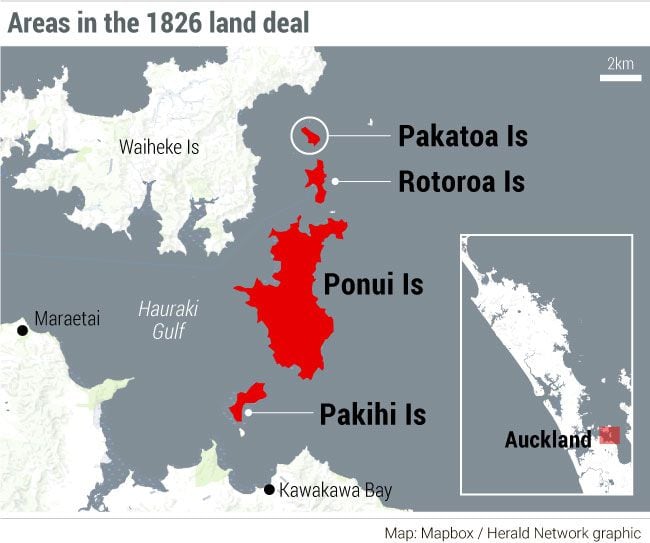
A historical document that reveals early colonisers buying islands in the Hauraki Gulf from Māori for “one double barrel gun, eight muskets and one barrel of powder” has surfaced at auction in London.
The tattered, water-stained 198-year-old deed, which is signed by eight Māori chiefs using their moko, or mark, represents the earliest organised attempt at the colonisation of Aotearoa.
Now, the rare, original artefact – signed on September 23, 1826, predating the Treaty of Waitangi by almost 14 years – is being offered for sale at Bonhams auction house in Knightsbridge, central London, next month with an estimate of NZ$61,000 to $100,000.
The agreement between local chiefs and officials from the first New Zealand Company, who arrived on the settler ship Rosanna, exchanged guns and powder for various parcels of land “in the district of Tamaki” and included Pakatoa, Rotoroa, Ponui and Pakihi islands “bounded in the west side by the eastuary [sic] named by Captain Cook The Thames and by the natives Te Cuppa”.
It included “all the trees growing” on the islands, as well as the creeks, bays, harbours and the sea for three miles “distant from their shores”.
/cloudfront-ap-southeast-2.images.arcpublishing.com/nzme/W2E2Y45ME5FODIF2TOLZHUWWUM.jpg) The land transaction document, signed by members of the first New Zealand Company and local Māori chiefs using their moko, is for sale by auction at Bonhams auction house in London. Photo / Supplied
The land transaction document, signed by members of the first New Zealand Company and local Māori chiefs using their moko, is for sale by auction at Bonhams auction house in London. Photo / Supplied
Thomas Kendall, one of New Zealand’s first Christian missionaries, whose career ended in disgrace, attests at the foot of the document how he has translated the deal to the chiefs and that they “fully understand the ... meaning of the contents”.
However, historian Vincent O’Malley, author of The Great War for New Zealand, raises doubts over the claims.
“In the 1820s, the prospects that Māori might have understood that transaction in the same way that Europeans would would be virtually nil,” he told the Herald.
“Māori had no conception of land sales. It wasn’t part of tikanga – a land sale was a completely foreign concept.”
A simple line map drawn on the back of the document shows the rough area involved in the sale, bordering “Wyheckee”, now Waiheke Island.
/cloudfront-ap-southeast-2.images.arcpublishing.com/nzme/VUT4QDEGAFEA5MEQHL4OWRN34I.jpg) The document is expected to fetch thousands of dollars. Photo / Supplied
The document is expected to fetch thousands of dollars. Photo / Supplied
The document, being offered as part of a “fine books and manuscripts” sale on March 20, has surfaced through the family of shipowner and merchant George Lyall (1779-1853), a trustee of the first New Zealand Company, which had limited success until merging with Edward Gibbon Wakefield’s New Zealand Association.
“This highly important document represents the earliest organised attempt at the colonisation of New Zealand by the first New Zealand Company in 1826, predating that of the second New Zealand Company of 1839,” Bonhams says.
“Not only is it one of the earliest land deeds from the colonial period, it is significant in that it is one of the earliest surviving documents bearing multiple moko signatures of Māori chiefs.”
However, the first New Zealand Company’s land bid was a failure.
/cloudfront-ap-southeast-2.images.arcpublishing.com/nzme/756YKSAL5FFP7AXIE62XX4HKHA.jpg) Captain James Cook gave English names to the area that New Zealand Company colonisers arranged to buy from Māori.
Captain James Cook gave English names to the area that New Zealand Company colonisers arranged to buy from Māori.
According to the 1966 book Old Manukau by A.E. Tonson, they became nervous about local Māori, abandoned the newly acquired land and set sail for the Bay of Islands. “This was a time of tribal war and finding traces of cannibal feasts, and disturbed by the numbers of canoes around, and the ferocious looks of the occupants, they changed their minds about staying.”
O’Malley said the first New Zealand Company’s efforts to buy Māori land were largely unsuccessful, despite offering highly sought-after goods.
“This transaction is taking place at the height of the Musket Wars, so every iwi is wanting access to firearms and ammunition and so on.
“It wasn’t uncommon for muskets to form part of the payment price for land at this time. There would be a range of goods – tobacco, blankets, all sorts of goods usually imported from Sydney.”
According to Auckland Council, the islands are part of the rohe (territory) of the Hauraki iwi, including Ngāi Tai, Ngāti Pāoa, Ngāti Whanaunga, Ngāti Tamaterā, Ngāti Te Ata and Ngāti Maru. The Hauraki Māori Trust Board, which represents these iwi, declined to comment on the sale.
Those aboard the Rosanna under Captain James Herd had already explored and charted the coastline searching for suitable settlement spots, from Stewart Island/Rakiura and Otago, up the South Island to Wellington and the Bay of Islands.
Scottish surveyor Thomas Shepherd, the so-called “agricultural superintendent of the New Zealand Company”, was greatly impressed by Hauraki Gulf, noting: “No part of New Zealand have we seen nor heard of equel [sic] to this for a commercial settlement nor for agricultural purposes”. The aspiring colonisers also held the mistaken belief that Pakihi, now also known as Sandspit Island, held iron ore deposits.
Bonhams says the document took the form of a pre-printed template with spaces left blank for completion with the details of each transaction and was drawn up by lawyers in Sydney and printed there.
After the first New Zealand Company’s return to England, the deed was placed in the possession of George Lyall, who would become a major figure in the East India Company.
The document has remained in the Lyall family since.
A photographic reproduction of the original deed is held at the Auckland Public Library. However, no other copies of the transaction are known.
The Ministry of Culture and Heritage monitors auctions within New Zealand but does not follow those held overseas.
It has no ability under legislation such as the Protected Objects Act 1975 to stop sales or force repatriation of material sold overseas.
O’Malley doubted that any New Zealand institution would be in a financial position to bid for the item.
“It would almost certainly go into private hands.”
Kurt Bayer is NZ Herald South Island Head of News based in Christchurch. He is a senior journalist who joined the Herald in 2011.
Take your Radio, Podcasts and Music with you









